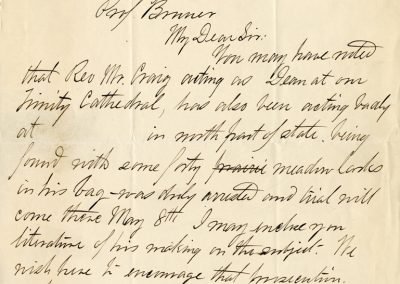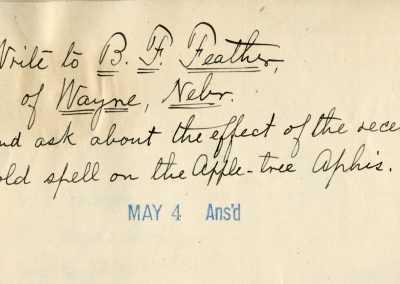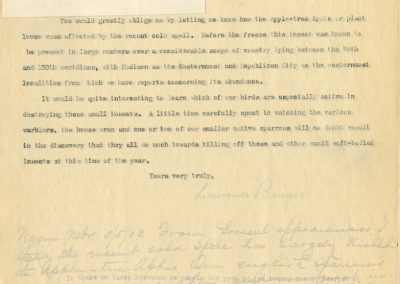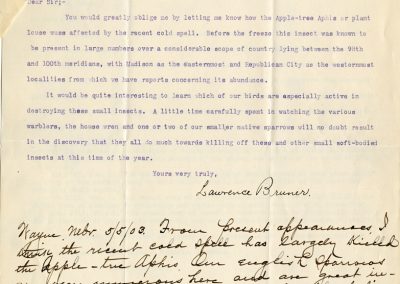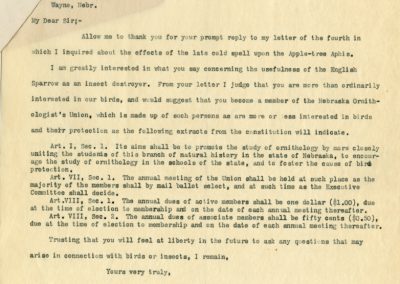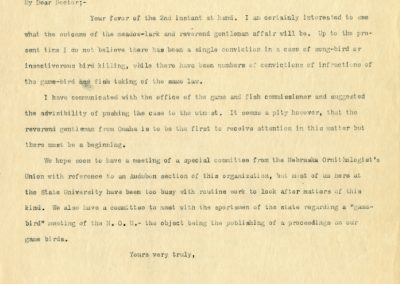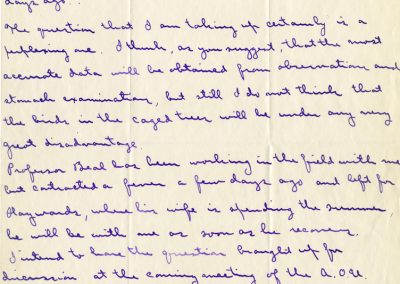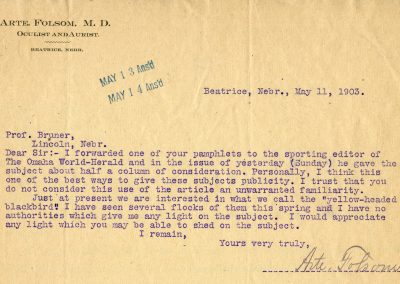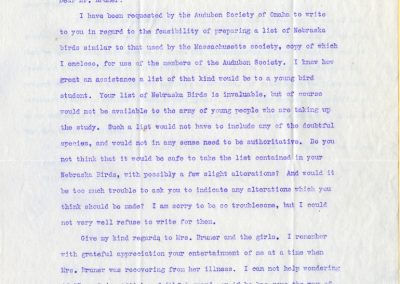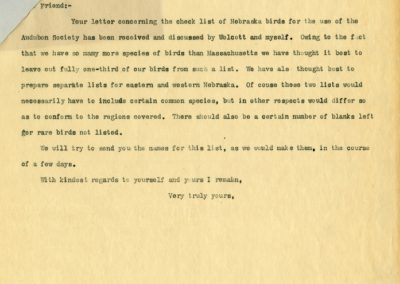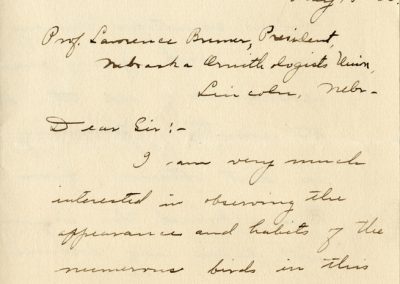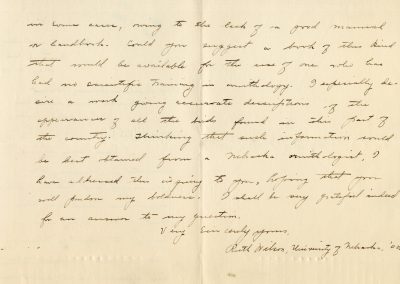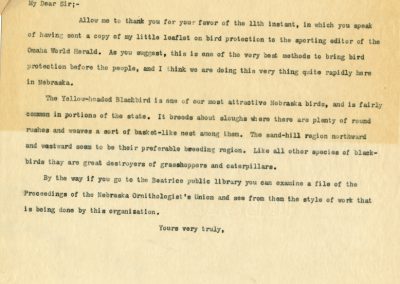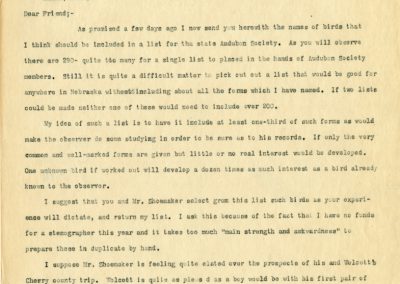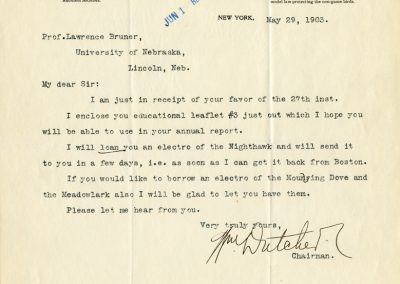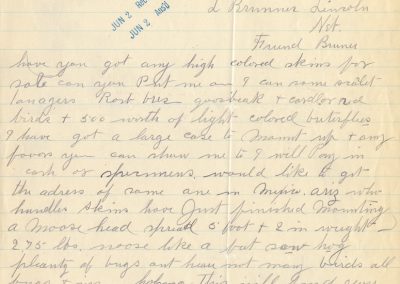Great Nebraska
Naturalists and ScientistsNebraska Ornithologists’ Union
Letters, 1903, May
1903, May 2
Dr. S. R. Towne, President
Miss Joy Higgins, Secretary
The Omaha Audubon Society,
For the Protection of Birds
344 South Thirtieth Street
Omaha, May 2 1903
May 4 Rec’d May 4 Ans’d
Prof Bruner
My Dear Sir:
You may have noted that Rev. Mr. Craig acting as Dean at our Trinity Cathedral, has also been acting badly at in north part of state being found with some forty meadowlarks in his bag – was duly arrested and trial will come there May 8th. I may enclose you literature of his making on the subject. We wish here to encourage that prosecution. How does it strike you? The meadowlark we made our Omaha emblem for a letter 8000 of which go to our school children.
[Illegible] S. R. Towne
1903, May 4
Write to B. F. Feather, of Wayne, Nebr. and ask about the effect of the recent cold spell on the Apple-tree Aphis.
May 4 Ans’d
May 4 Ans’d
Lincoln, Nebr., May 4, 1903.
You would greatly oblige me by letting me know how the Apple-tree Aphis or plant louse was affected by the recent cold spell. Before the freeze this insect was known to be present in large numbers over a considerable scope of country lying between the 98th and 100th meridians, with Madison as the easternmost and Republican City as the westernmost localities from which we have reports concerning its abundance. It would be quite interesting to learn which of our birds are especially active in destroying these small insects. A little time carefully spent in watching the various warblers, the house wren and one or two of our smaller native sparrows will no doubt result in the discovery that they all do much towards killing off these and other small soft-bodied insects at this time of the year.
Yours very truly,
uner, Professor
ent, Experiment Station
State Entomologist
Lincoln, Nebr., May 4, 1903.
Feather,
Wayne, Nebr.
Dear Sir;-
You would greatly oblige me by letting me know how the Apple-tree Aphis or plant louse was affected by the recent cold spell. Before the freeze this insect was known to be present in large numbers over a considerable scope of country lying between the 98th and 100th meridians, with Madison as the easternmost and Republican City as the westernmost localities from which we have reports concerning its abundance.
It would be quite interesting to learn which of our birds are especially active in destroying these small insects. A little time carefully spent in watching the various warblers, the house wren and one or two of our smaller native sparrows will no doubt result in the discovery that they all do much towards killing off these and other small soft-bodied insects at this time of the year.
Yours very truly,
Wayne Nebr. 5/5/03. From present appearances I think the recent cold spell has largely killed the Apple-tree Aphis. Our English sparrows are very numerous here and are great insect destroyers, which but few people believe, still it is a fact. All fruit is largely [illegible] here.
Yours tc
B. F. Feather
May 6 Rec’d
May 7 Ans’d
1903, May 4
Lincoln, Nebr., May 7, 1903.
F. Feather,
Wayne, Nebr.
My Dear Sir;-
Allow me to thank you for your prompt reply to my letter of the fourth in which I inquired about the effects of the late cold spell upon the Apple-tree Aphis.
I am greatly interested in what you say concerning the usefulness of the English Sparrow as an insect destroyer, From your letter I judge that you are more than ordinarily interested in our birds, and would suggest that you become a member of the Nebraska Ornithologist’s Union, which is made up of such persons as are more or less interested in birds and their protection as the following extracts from the constitution will indicate.
Art. I, Sec. 1. Its aims shall be to promote the study of ornithology by more closely uniting the students of this branch of natural history in the state of Nebraska, to encourage the study of ornithology in the schools of the state, and to foster the cause of bird protection.
Art VII, Sec. 1. The annual meeting of the Union shall be held at such place as the majority of the members shall by mail ballot select, and at such time as the Executive Committee shall decide.
Art.VIII, Sec. 1. The annual dues of active members shall be one dollar ($1.00), due at the time of election to membership and on the date of each annual meeting thereafter.
Art VIII, Sec. 2. The annual dues of associate members shall be fifty cents ($0.50), due at the time of election to membership and on the date of each annual meeting thereafter. Trusting that you will feel at liberty in the future to ask any questions as that may arise in connection with birds or insects, I remain,
Yours very truly,
1903, May 4
Lincoln, Nebr., May 4, 1903.
Dr. S. R. Towne,
Omaha, Nebr.
My Dear Doctor;=
Your favor of the 2nd instant at hand. I am certainly interested to see what the outcome of the meadow-lark and reverend gentleman affair will be. Up to the present time I do not believe there has been a single conviction in a case of song-bird or insectivorous bird killing, while there have been numbers of convictions of infractions of the game-bird and fish taking of the same law.
I have communicated with the office of the game and fish commissioner and suggested the advisibility of pushing the case to the utmost. It seems a pity however, that the reverend gentleman from Omaha is to be the first to receive attention in this matter but there must be a beginning.
We hope to have a meeting of a special committee from the Nebraska Ornithologist’s Union with reference to an Audubon section of this organization, but most of us here at the State Unviersity have been too busy with routine work to look after matters of this kind. We also have a committee to meet with the sportsmen of the state regarding a “game-bird” meeting of the N. O. U.-the object being the publishing of a proceedings on our game birds.
Yours very truly,
1903, May 6
University of California
College of Agriculture
Berkeley, California
Agricultural Experiment Station
F. W. Hilgard Director
May 11 Rec’d
My dear Professor:-
Your letter of Apr. 17th reached me a few days ago. The question that I am taking up certainly is a perplexing one. I think, as you suggest, that the most accurate data will be obtained from observation and stomach examination, but still I do not think that the birds in the caged trees will be under any very great disadvantage.
Professor Beal has been working in the field with me but contracted a fever a few days ago and left for Haywards, where his wife is spending the summer, he will be with me as soon as he recovers. I intend to have the question brought up for discussion at the coming meeting of the A. O. U. which will be held in San F. on the 15th & 16th of this month.
Thanking you for your kind intent and good wishes I remain
Very truly yours
J. S. Hunter
1903, May 11
Arte. Folsom, M. D.
Oculist and Aurist.
Beatrice, Nebr.
May 13 Ans’d
May 14 Ans’d
Beatrice, Nebr., May 11, 1903.
Prof. Bruner,
Lincoln, Nebr.
Dear Sir:- I forwarded one of your pamphlets to the sporting editor of The Omaha World-Herald and in the issue of yesterday (Sunday) he gave the subject about half a column of consideration. Personally, I think this one of the best ways to give these subjects publicity. I trust that you do not consider this use of the article an unwarranted familiarity.
Just at present we are interested in what we call the “yellow-headed blackbird.” I have seen several flocks of them this spring and I have no authorities which give me any light on the subject. I would appreciate any light which you may be able to shed on the subject.
I remain,
Yours very truly,
Arte. Folsom
1903, May 12
THE VAN SANT SCHOOL OF SHORTHAND AND TYPEWRITING
716-717-718 New York Life
Building Omaha, Nebraska, May 9, 1903.
May 11 Rec’d
May 12 Ans’d
Prof. Lawrence Bruner.
Lincoln, Nebr.
Dear Mr. Bruner:
I have been requested by the Audubon Society of Omaha to write to you in regard to the feasibility of preparing a list of Nebraska birds similar to that used by the Massachusetts society, copy of which I enclose, for use of the members of the Audubon Society. I know how great an assistance a list of that kind would be to a young bird student. Your list of Nebraska Birds is invaluable, but of course would not be available to the army of young people who are taking up the study. Such a list would not have to include any of the doubtful species, and would not in any sense need to be authoritative. Do you not think that it would be safe to take the list contained in your Nebraska Birds, with possibly a few slight alterations? And would it be too much trouble to ask you to indicate any alterations which you think should be made? I am sorry to be so troublesome, but I could not very well refuse to write for them.
Give my kind regards to Mrs. Bruner and the girls. I remember with grateful appreciation your entertainment of me at a time when Mrs. Bruner was recovering from her illness. I can not help wondering if “Puggy” is still her faithful guard, or if he has gone the way of all good dogs.
Sincerely yours.
Elizabeth Van Sant
1903, May 12
Lincoln, Nebr., May 12, 1903.
th Van Sant,
ha, Nebr.
Friend:-
Your letter concerning the check list of Nebraska birds for the use of the Audubon Society has been received and discussed by Wolcott and myself. Owing to the fact that we have so many more species of birds than Massachusetts we have thought it best to prepare separate lists for eastern and western Nebraska. Of course these two lists would necessarily have to include certain common species, but in other respects would differ so as to conform to the regions covered. There should also be a certain number of blanks left for rare birds not listed.
We will try to send you the names for this list, as we would make them, in the course of a few days.
With kindest regards to yourself and yours I remain,
Very truly yours,
1903, May 13
May 14 Rec’d
May 14 Ans’d
835 Lexington Ave.,
Hastings, Nebr.
May 12 – 03.
Prof. Lawrence Bruner, President
Nebraska Ornithologists Union
Lincoln, Nebr.
Dear Sir:-
I am very much interested in observing the appearance and habits of the numerous birds in this part of the state and in trying to identify them. The problem of identification has become a difficult one
Very sincerely yours,
Ruth Wilson, University of Nebraska, ’00.
1903, May 14
Lincoln, Nebr., May 14, 1903.
Mr. Arte Folsom M.D.
Beatrice, Nebr.
My Dear Sir:-
Allow me to thank you for your favor of the 11th instant, in which you speak of having sent a copy of my little leaflet on bird protection to the sporting editor of the Omaha World Herald. As you suggest, this is one of the very best methods to bring bird protection before the people, and I think we are doing this very thing quite rapidly here in Nebraska.
The Yellow-headed Blackbird is one of our most attractive Nebraska birds, and is fairly common in portions of the state. It breeds about sloughs where there are plenty of round rushes and weaves a sort of basket-like nest among them. The sand-hill region northward and westward seem to be their preferable breeding region. Like all other species of blackbirds they are great destroyers of grasshoppers and caterpillars.
By the way if you go to the Beatrice public library you can examine a file of the Proceedings of the Nebraska Ornithologist’s Union and see from them the style of work that is being done by this organization.
Yours very truly,
1903, May 19
Lincoln, Nebr., May 19, 1903.
Miss Elizabeth Van Sant,
Omaha, Nebr.
Dear Friend;-
As promised a few days ago I now send you herewith the names of birds that I think should be included in a list for the state Audubon Society. As you will observe there are 290-quite too many for a single list to place in the hands of Audubon Society members. Still it is quite a difficult matter to pick out a list that would be good for anywhere in Nebraska without including about all the forms which I have named. If two lists could be made neither one of these would need to include over 200.
My idea of such a list is to have it include at least one-third of such forms as would make the observer do some studying in order to be sure as to his records. If only the very common and well-marked forms are given but little or no real interest would be developed. One unknown bird if worked out will develop a dozen times as much interest as a bird already known to the observer.
I suggest that you and Mr. Shoemaker select from this list such birds as your experience will dictate, and return my list. I ask this because of the fact that I have no funds for a stenographer this year and it takes too much “main strength and awkwardness” to prepare these in duplicate by hand.
I suppose Mr. Shoemaker is feeling quite elated over the prospects of his and Wolcotts Cherry county trip. Wolcott is quite as pleased as a boy would be with his first pair of red-topped boots. Wish that I could be one of the party myself, but the fates decree otherwise.
Very cordially yours,
1903, May 29
American Ornithologists’ Union.
Founded 1883. Incorporated 1888.
William Dutcher, Chairman,
Protection Committee, North American Birds,
525 Manhattan Avenue,
New York City.
Map showing (shaded) states having Audubon Societies.
Map showing (shaded) States which have adopted the A.O.U. model law protecting the non-game birds.
Jun 2 Ans’d
Jun 1 Rec’d
New York, May 29, 1903.
Prof. Lawrence Bruner,
University of Nebraska,
Lincoln, Neb.
My dear Sir:
I am just in receipt of your favor of the 27th inst. I enclose you educational leaflet #3 just out which I hope you will be able to use in your annual report.
I will loan you an electro of the Nighthawk and will send it to you in a few days, i.e. as soon as I can get it back from Boston.
If you would like to borrow an electro of the Mourning Dove and the meadowlark also I will be glad to let you have them.
Please let me hear from you.
Very truly yours,
Wm Dutcher Chairman.
1903, May 29
F. J. Brezee
Taxidermist.
Taxidermy in all its Branches
Special Attention Given to Collecting for Collages and chools.
No 303 1/2 Third Street.
Portland, Ore. May 29 1903
Jun 2 Rec’d Jun 2 Ans’d
L Brunner Lincoln
Neb.
Friend Bruner
have you got any high colored skins for sale can you Put me on 9 can some scarlet tanagers Rosb bres grosbeak & cardlor red birds & 500 worth of light colored buterflies [sic] I have got a large case to mount [illegible] & any favors you can show me to I will Pay in cash or specimens would like to get the adress [sic] of some one in Mexico, Ariz who handles skins have Just finished Mounting a Moose head spread 5 foot & 2 in weight 257 lbs. noose like a bat sow hog pleanty [sic] of bugs out hear [sic] not many birds all bugs & ins___ hoping this will find you & your wife & babies in hapy [sic] days & in health & am up to 150 lbs more than ever I have of my own say a twenty hundred dolar colection [sic] I have ove [sic] 50 pheasant on hand so if any one wants a nice Pr for some buterflies [sic] & skin I will give them the best of it Brezee.
